Barbarous radiates
Unofficial coins of the Gallo-Roman empire struck AD 259-274
in the names of Postumus and Victorinus (scarce) and Tetricus I and II (extremely common).
The Gallo-Roman Empire began with Postumus (259-269) and continued until it was reconquered from Tetricus I (271-274) for the central empire by emperor Aurelian in 274 (a note on dates). Although official coins of the Gallo-Roman emperors are common, there was apparently demand for far more coins than were produced officially and the need was filled by unofficial, locally produced, "barbarous radiates" of varying degrees of fidelity to the originals.
Tetricus I, 271-274. The most common barbarous radiates are in the name of Tetricus I. Here is an official coin of his along with five barbarous radiates of various sizes.
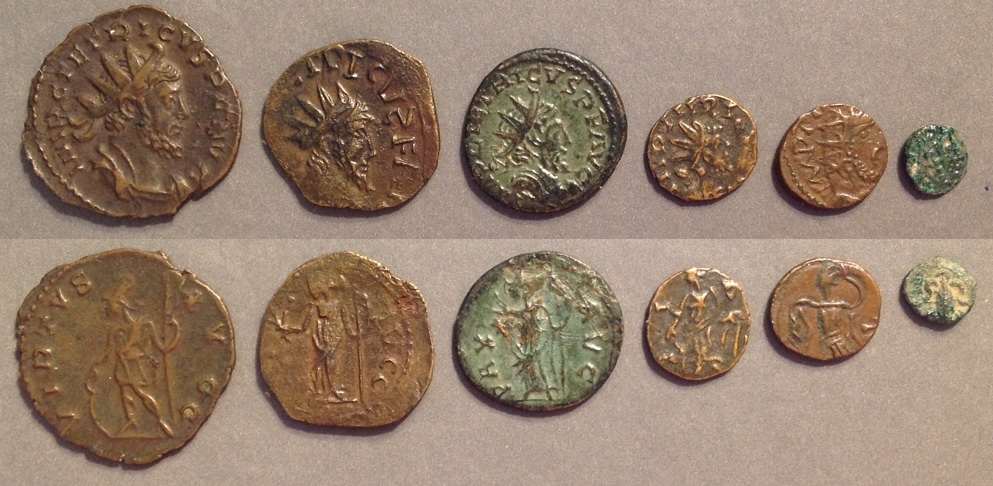 Left: 20 mm. Official. IMP C TETRICVS PF AVG / VIRTVS AVGG.
Left: 20 mm. Official. IMP C TETRICVS PF AVG / VIRTVS AVGG.
Second: 17 mm. Crude bust. ...TCICVS F A... [S retrograde] / SPES AVGG, Spes standing
Third. 16 mm. Well-executed, but too small to be official. IMP C TETRICVS PF AVG / PAX AVG, Pax standing
Fourth: 11 mm. A remarkable attempt at dies small enough to strike a type complete with legend. IMP TETRI.../figure standing
Fifth: 10 mm. Crude bust and reverse with little attempt at a legend. IMP T.../figure standing
Sixth, right: 6 mm. Bearded head right fills the flan/tiny uncertain figure.
There are some still-smaller barbarous radiates, but their designs are hardly identifiable.
To give a better feeling for the size of the smallest one above, here it is compared to a US cent:  Note for collectors: Official coins of the Tetrici are very common but very seldom have a good strike. There are some official coins with very good portraits, but it is very rare to find one with a good strike from fresh dies that is excellent on both sides.
Note for collectors: Official coins of the Tetrici are very common but very seldom have a good strike. There are some official coins with very good portraits, but it is very rare to find one with a good strike from fresh dies that is excellent on both sides.
A small fraction of barbarous radiates are almost as well-executed as the originals, but most are much cruder in design and execution and most are distinctly smaller than originals. Many are very much smaller than originals and impossible to mistake for official coins. Nevertheless, they were made in large numbers and played a substantial role in the monetary system of Gaul and Britain.
When were they minted? The evidence suggests that almost all imitations were imitations of current Gallo-Roman coins. There is very little evidence that "barbarous radiates" continued to be minted after the fall of the Gallo-Roman Empire in 274. The extreme rarity of barbarous radiates that imitate a type demonstrably post-Tetricus suggests they ceased being struck almost immediately upon Aurelian's reconquest of the West.
Tetricus II, 271-274. Barbarous radiates of Tetricus I are the most common, followed by those of Tetricus II, his son and Caesar, who is distinguished from his bearded father by being unbearded. His title CAES would also distinguish him, but it is usually not legible on barbarous radiates.
 Tetricus II, 271-274.
Tetricus II, 271-274.
One official and four imitations.
Left: 20 mm. Official. C PIV ESV TETRICVS CAES/SPES AVGG, Spes walking left holding out flower (which is his most common type).
Second: 19 mm. Nearly full size, but crude. (The two sides have much different patination.) IVP TETRICVS ... [S retrograde]/garbled letters attempted on the reverse.
Third: 18 mm. Nearly full size, with a real attempt to imitate an original. ..PIV ES TETRICVS CAES, curly hair along the hairline, not seen on official coins/SALVS AVGG, Salus standing
Forth: 9 mm. Tiny SPES AVGG imitation, with dies almost small enough for the small flan and an attempt at the lettering.
Fifth (Right): 10 mm. Crude imitation. It could be of either Tetricus, but there is no clear beard so I assign it to Tetricus II.
Emperors on barbarous radiates. Most barbarous radiates are of the last Gallo-Roman emperors, Tetricus I (above) and his son Tetricus II (above). Some barbarous radiates imitate coins of the earlier Gallo-Roman emperors
• Postumus (next) and
• Victorinus (below).
Imitations of the short-lived Gallo-Roman emperors Laelianus and Marius, if they exist, must be extremely rare.
Some barbarous radiates are of emperors of the central empire
• Gallienus (below) and
• Claudius II (below), especially his CONSECRATIO coins.
Next is a selection for each. Almost all of the coins illustrated below were found in England, although barbarous radiates are also common from France (Gaul).
Postumus, 259-269. Postumus was the first Gallo-Roman emperor, assuming power in 259 at about the time Valerian was captured in battle against the Sasanians in the east and Gallienus became sole central emperor. Almost all Postumus coins are official. However, some full-size imitations of Postumus coins are found. Shortly after his reign imitations began to be smaller and imitations were no longer struck in the name of Postumus.
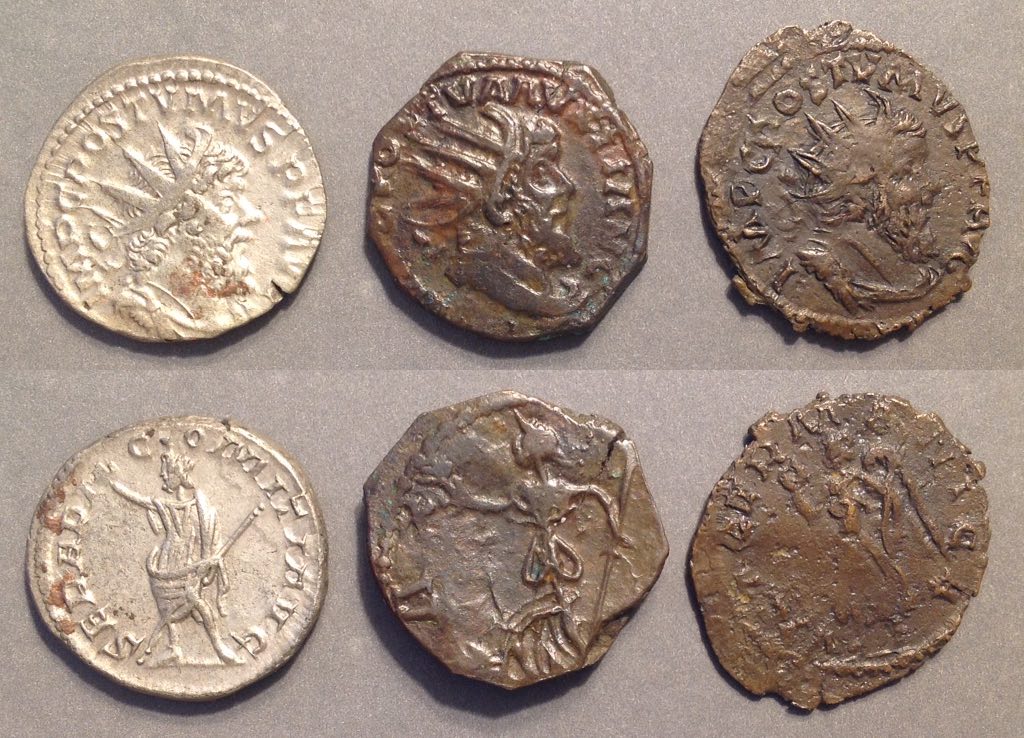
Postumus, 259-269
An official coin and two imitations.
Left. 21 mm. Official. IMP C POSTVMVS PF AVG
/ SERAPI COMITI AVG, Serapis standing left.
Second: 22 mm and thick. Unofficial. Lower silver content, but a good attempt at the design and legend. PAX AVG
Third: 23 mm and thin. A good imitation of the obverse portrait and legend/VICT GERMANICA, Victory advancing left, a type not known in official style for Postumus. If this coin were actually official, and its style is not far off, it would be important and very rare.
The line between official and imitation is very fine for coins of Postumus. Some huge hoards such as the one documented in The Cunetio Treasure (a hoard of 55,000 coins found in England) have many imitations. The authors Besly and Bland identified 12,543 coins of Postumus as official and 1259 as imitations. The imitations are mostly so good that dealers would usually sell them as official. Some of the Cunetio imitations have crude portraits, but I would attribute most they called "irregular" as official, just the expected worst end that any large distribution has.
Victorinus, 269-271. Victorinus issued very many official coins but his imitations are scarce. The rare smaller imitations with his name were probably not issued until later under Tetricus.
 Victorinus, 269-271
Victorinus, 269-271
One official coin and three barbarous radiates.
Left: 21 mm. IMP C VICTORINVS PF AVG/SALVS AVG, Salus.
Second: 18 mm. IMP C VICTORINVS PF AVG / INVICTVS. Unusually good silver.
Third: 17 mm. OFT III DVX, Fortuna Redux with rudder (rendered more like an anchor) and cornucopia. The nose has the curvature it has on official portraits of Victorinus.
Right: 10 mm. ... VICTOR..
It is highly unusual to find a small barbarous radiate on which the legend can be attributed to Victorinus.
Laelianus and Marius, 271. Laelianus rebelled against Postumus and was defeated within a month or two. Then Postumus was assassinated and Marius became emperor. Ancient sources says he lasted two days, but his coins are numerous enough to indicate he lasted maybe three months. Official coins of Laelianus are very rare and official coins of Marius are rare. I have not seen a barbarous radiate with an obverse naming Laelianus or Marius. But the next coin with an obverse of Tetricus has a reverse type of Marius.
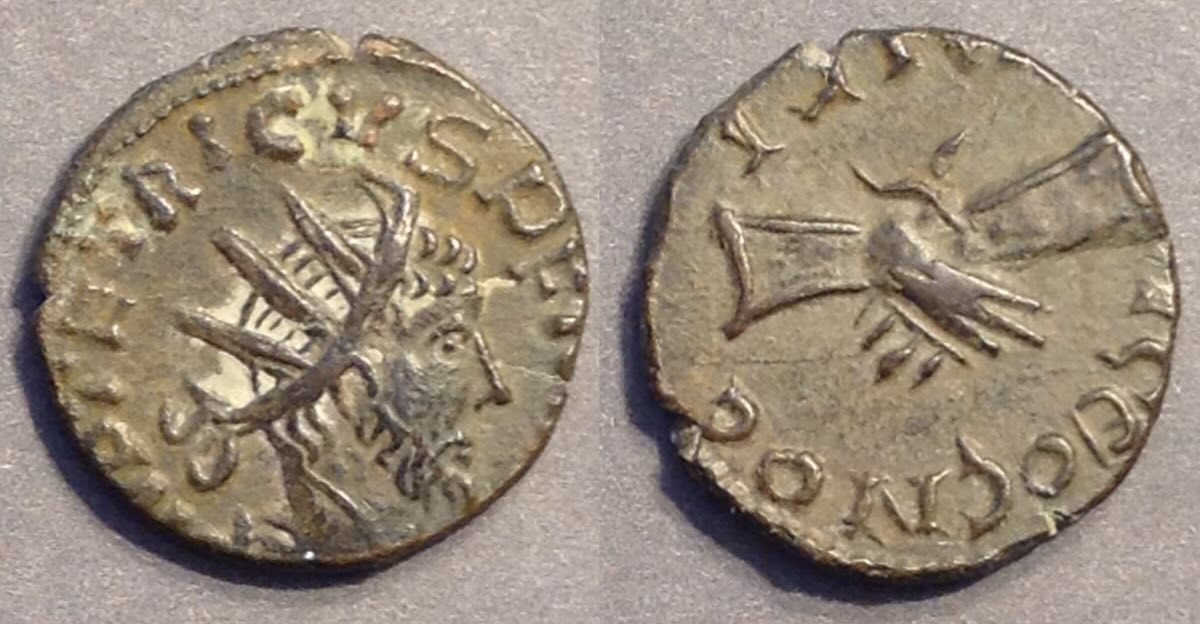 Tetricus I
Tetricus I
16 mm.
IMP TETRICVS PF AVG
Clasped hands, lettering around resembling the
CONCORDIA MILITVM
reverse type of Marius.
Among the Gallo-Roman emperors only Marius issued a clasped-hands type,
so the obverse and reverse of this piece imitate different coins.
Many ancient imitations pair obverses and reverses that do not belong together--they are called mules or hybrids.
Claudius II, Central-empire emperor, 268-270. Almost all imitations in his name are of his DIVO pieces with CONSECRATIO and either an altar or an eagle.
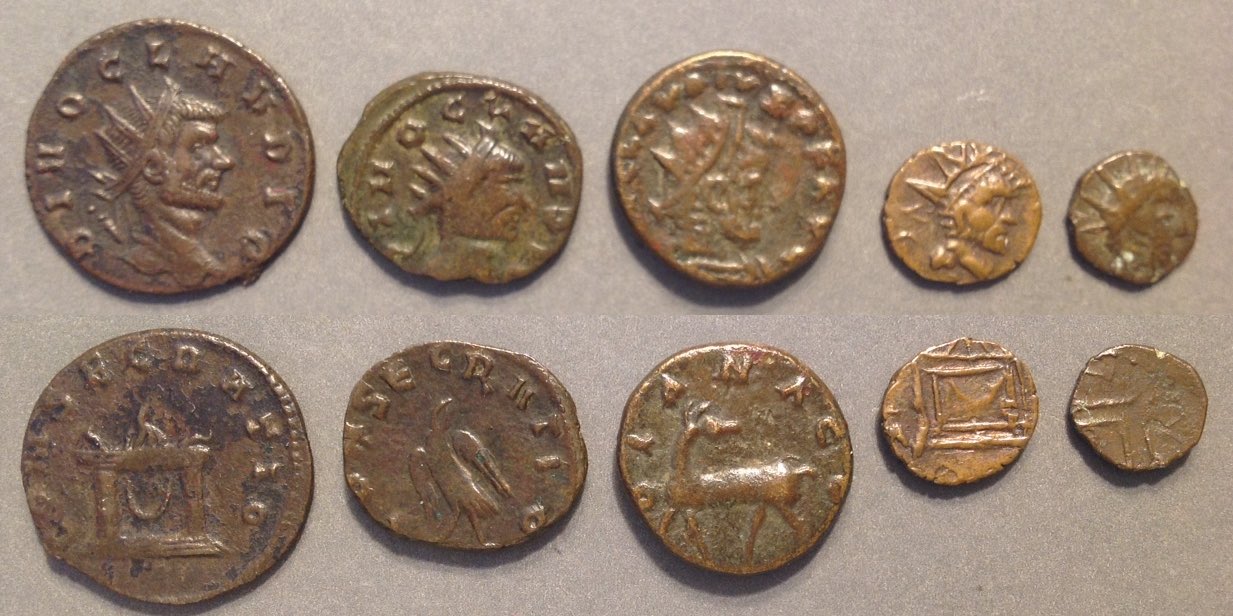
Claudius II, 268-270
An official coin and four imitations.
Left: 20 mm. Official. DIVO CLAVDIO / CONSECRATIO, altar
Second: 17-15 mm. Imitation with nearly correct lettering, eagle
Third: 17 mm. Thick. Hybrid imitation with a reverse of Gallienus
... CLAVDIVS PF AVG / DIANA GG, doe left. This type is extremely unusual.
Fourth: 11 mm. Altar reverse
Fifth (right): 10 mm. Traces of altar reverse.
Gallienus, 253-268, central empire emperor. Imitations of Gallienus are different. He was emperor a long time and in the normal course of events there would be some imitations of his coins, so not all imitations of coins of Gallienus are barbarous radiates associated with the Gallo-Roman empire. The Cunetio Treasure had 2604 coins attributed as official from the sole reign of Gallineus and 145 as "irregular." The irregular coins make an attempt to have proper lettering and a regular reverse type and legend; they seem to be distinguished by slightly smaller poor flans and slightly cruder engraving, but they are not very small like so many coins of the Tetrici.
The line between "official" and "irregular" (or "imitation" a.k.a. "barbarous radiate") can be very fine. Sometimes small ancient counterfeiters dens have been discovered archaeologically and then we can know their products are irregular "barbarous radiates"--but usually those are obvious anyway.
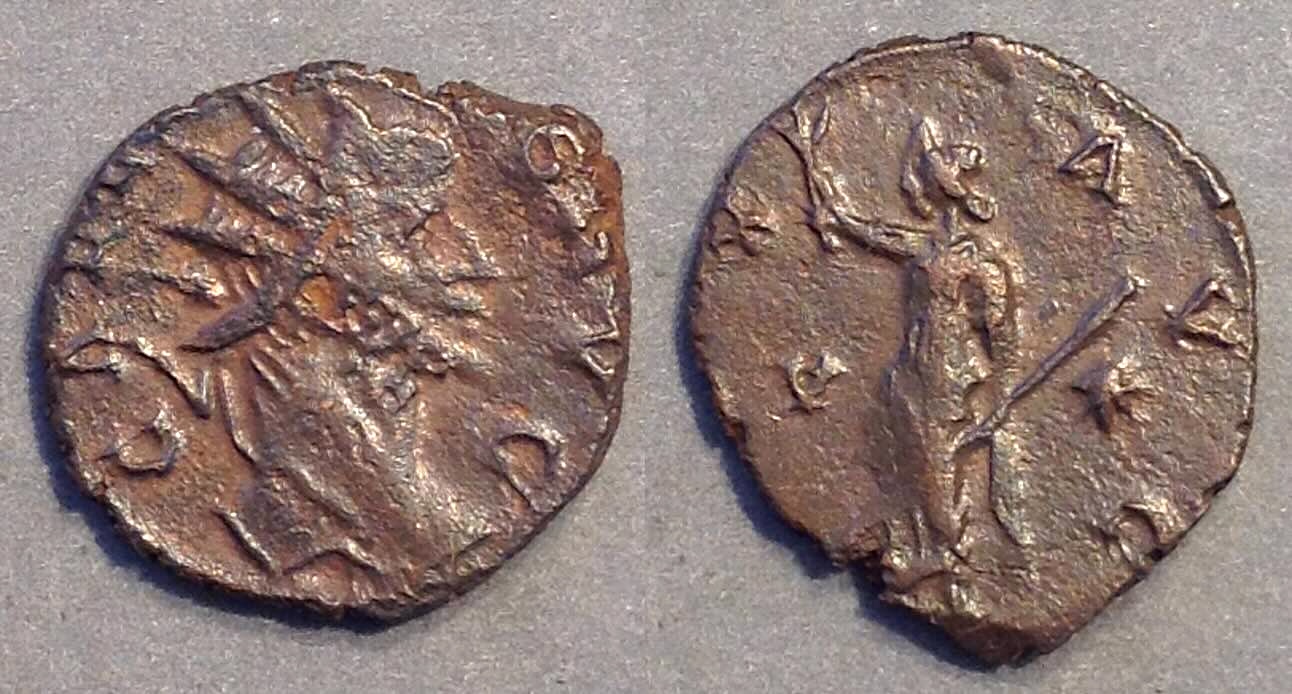 Gallienus
Gallienus
19 mm.
In Cunetio this would be called "irregular." It has the characteristics of an official coin except for the poor flan and strike. It might be an official mint issue--just poorly done.
GALLIENVS AVG
PAX AVG. Pax standing left holding flower and transverse scepter.

Gallienus
17 mm. Thick.
A portrait of Gallienus with a passable imitation of the lettering
IMP GALLIENVS AVG
PAX AVG
This coin has enough irregularities to call it an imitation.
Some imitations of coins of Gallienus are properly called barbarous radiates. This one was found in England.
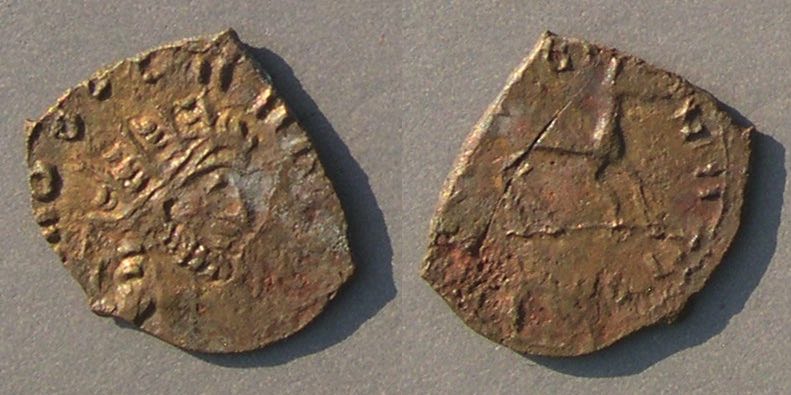 Gallienus?
Gallienus?
20 mm.
Portraits with short beard and letter-like form around.
Animal (deer?) standing right as is common on coins of the last issue of Gallienus with legend
DIANAE CONS AVG (prototype c. 268)
Dates. The dates of the reigns in this era are subject to scholarly debate. For example, it used to be thought that Tetricus ruled 270-273, but now his reign has been moved one year later.
I have spent many hours in major numismatic libraries seeking articles on barbarous radiates. Old articles from the first half of the 20th century still entertained thoughts that the small ones were "Dark Ages" coins from after the Romans left Britain c. 408. We now know that erroneous inference was based merely on the quality of the coins (They are so bad, they must be from the Dark Ages!), not any objective evidence. Then the question became, how long after the fall of the Gallo-Roman empire did they last? What were the latest types imitated?
Barbarous radiates have been found in North Africa. Some are small like AE4 coins known to be Vandal. Should we infer that some barbarous radiates are from the time of the Vandals (Dark Ages, again)? No. When they were demonetized in Gaul they were still recognizably coins, so some coins that were useless in Gaul were transported to Africa to serve as small change.
Some of the poorly-executed small imitations are hard to identify with a particular emperor. I have an old article that optimistically attributes a coin to Probus (276-282) even though it has no legible legend and a long beard and only the slightest hint of a reverse type of Probus among thousands of coins in the hoard. Surely it is Tetricus I. Another old article has a photo of a coin where the author reconstructs "TACI.." out of a blundered legend and attributes it to Tacitus (276), again with a beard just like Tetricus I. Surely it is just a Tetricus I imitation.
Next are two coins from Britain, collected from among many thousands, that give slight hints of being among the latest barbarous radiates.
The latest barbarous radiates. Look at the next two coins. What did they have for a prototype? Maybe they don't need a prototype, but most authors think every imitation imitates some official coin type, however poorly. What is different about the next two?
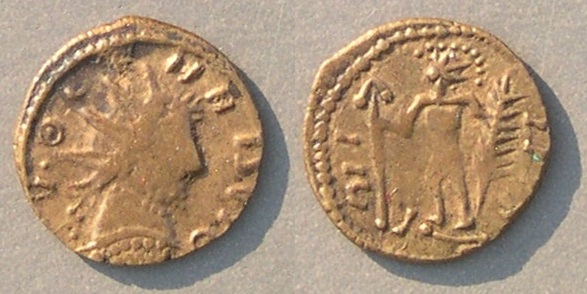 14 mm.
14 mm.
The reverse type has the long palm branch of Hilaritas, which is on coins of Tetricus I. Official coins would not combine it with a spear. That is different, but not indicative of the date.
The legend is not legible. It is only letter-like shapes, not actual letters.
The bust type is unusual. The dotted, chain-mail-like, shoulder resembles shields on coins of Probus. The beard of dots is more pointed than the beard of Probus on official coins, but not long like the beard on most Tetricus coins.
All together, it is not enough to prove it had a prototype after Tetricus I.
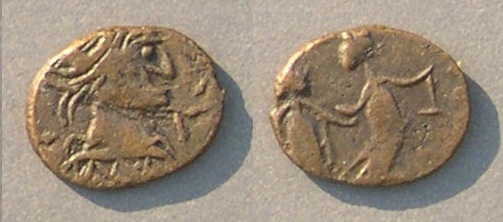 11-9 mm.
11-9 mm.
The obverse could be imitating anyone, but the reverse is highly unusual for barbarous radiates--it has a two-figure type. Gallineus had types with two figures on the reverse (e.g. PIETAS AVGG), but the Gallo-Roman emperors did not. Reverse types with two figures resumed under Aurelian. The dates of Aurelian 270-275 overlap those of Tetricus I, 271-274, so this is not proof of a later prototype. But, it is a slight hint that barbarous radiates were still being made after coins of Aurelian began to circulate in the west.
My inspection of thousands of barbarous radiates yields no better evidence than those two coins. I have read numerous articles on hoards of barbarous radiates that do not have any convincing evidence that they continued to be issued significantly after the reconquest by Aurelian in 274. The evidence suggests that they were made in numerous small unofficial minting/counterfeiting operations all across the Gallic Empire.
Conclusion. Barbarous radiates are unofficial imitations of coin types of the Gallo-Roman emperors. A few are nearly full-sized, but most are smaller or much smaller than their prototypes. The majority imitate Tetricus I or Tetricus II, the last Gallo-Roman emperors. As for the other emperors, barbarous radiates of Claudius II are common and for Postumus and Victorinus they are less common, but not rare. They may be unknown in the names of Laelianus and Marius.
The numerous small minting operations that produced barbarous radiates discontinued production c. 274 when Aurelian reunited Gaul with the rest of the empire.
Here is an excellent article on barbarous radiates in England: https://finds.org.uk/counties/blog/coin-relief-issue-nineteen/
Here are more images of barbarous radiates: http://augustuscoins.com/pages/edit/coins/ed/imit/BRextra.html
Go to the main page on ancient imitations.
Go to the main Table of Contents page for this whole group of educational pages.
See a page of reference works on barbarous radiates.
 Left: 20 mm. Official. IMP C TETRICVS PF AVG / VIRTVS AVGG.
Left: 20 mm. Official. IMP C TETRICVS PF AVG / VIRTVS AVGG. 









 11-9 mm.
11-9 mm.